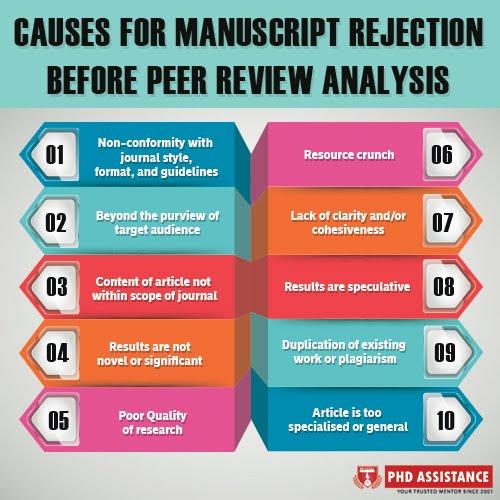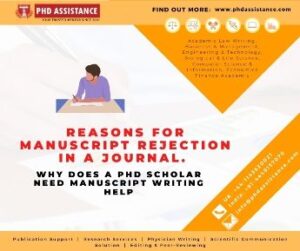Reasons for Manuscript Rejection in a journal. Why does a PhD Scholar need Manuscript Writing Help?
In Brief about why a Manuscript Rejected?
The editorial board of a journal usually makes decisions on which publications are written. Manuscripts are refused at one of two stages in the approval process for most publications. An editorial dismissal is the first step. The journal editor issues this kind of denial, which usually occurs within 12 weeks of submission. At this point, editors reject manuscripts for one or more technical reasons:
● The manuscript is lacking key elements or portions that the journal needs. The Instructions to Authors usually explain the essential elements or parts.
● The manuscript topic is not likely to concern the chosen journal’s readership or falls short of its Aims and Scope.
● There is a lack of scholarship in the paper. It is insufficiently cited, lacks or fails to mention relevant literature in the field, or the sources are out of date. Parts of the text may have been plagiarized, according to the article, PhD Manuscript Peer review of journal.
Introduction about Common Reasons for Manuscript Rejection:
A manuscript can be rejected for various purposes, but the most common ones are technical and editorial.
Technical Reasons for Rejection Include:
- Incomplete evidence, such as a limited sample size, missing or inadequate controls
- Inadequate analysis, such as the use of incorrect mathematical measures or a complete lack of statistics Inappropriate technique for addressing your hypothesis or the use of an outdated Methodology that has been superseded by modern, more efficient approaches that provide more reliable results
Below are some of the Editorial Reasons for Rejection:
- Research ethics, such as patient consent or ethics committee approval for animal research, are ignored.
- Inadequate structure or failure to adhere to journal formatting requirements
- Due to a lack of necessary detail, readers cannot entirely comprehend and repeat the authors’ interpretation and experiment. A lack of current sources or references with a high percentage of self-citations
- It is written in a weak language that audiences are unable to comprehend.

Why Does a PhD Scholar need Manuscript Writing Help?
The Manuscript Choice is thought to be a good substitute for a standard dissertation text. The student profits from the manuscript choice because it adds to their publishing record.
Definitions
Writing in the style, substance, and structure of a particular Peer-Reviewed, professional Journal appropriate to the Manuscript’s content is described as “suitable for publication.” The manuscripts do not have to be sent for submission or written to be considered suitable for publication. When a manuscript is deemed ready for submission, the student’s counselor takes the final call and the advisor may seek feedback from the PhD Manuscript Writing Services committee before making a decision.
Requirements and Approval
The research had to be done under the supervision of a University graduate faculty member. During the dissertation, the recipient must be enrolled for the requisite graduation credits at the university. The student’s advisor and PhD Dissertation Manuscript Writing Help Committee must sign off on the manuscript choice in writing, and they are responsible for guiding the substance of the entire dissertation, including the manuscripts. The student’s counsellor approves the material in the end.
- The manuscript choice should be accepted as soon as their research subject has been approved, ideally before the research begins.
- Manuscripts: A minimum of two and a maximum of three publishable manuscripts are required. At least one manuscript must be data-driven and report new/unique details of the study’s key findings. On all manuscripts, the student should be the first author.
Acknowledgements
- An introductory chapter – at a minimum, it introduces the dissertation’s general topic, describes how the manuscripts and chapters approach the theme and explain how the manuscripts relate to one another. The introduction should also address the general need and relevance of the research subject and analysis and the uniqueness of the results.
Specific material — The following information should be used in one of the manuscripts or as a separate chapter: a summary of relevant literature; a theoretical framework/model/theory; a summary of the methods, including concept, hypothesis, procedures, and research plan; relevant primary and secondary observations, including the required form of supporting evidence and analysis/statistical outcomes, and hypotheses relating to specific findings, including an understanding of the significance of the specific findings and a comparison to previous literature.
- Synthesis chapter – at a minimum, a synthesis and analysis of the study’s overall results that demonstrates the incorporation of the material of both manuscripts and chapters and an appreciation of the unifying thread, discussion of the whole collection of findings’ new/original relevance to the body of research, and a clarification of the manuscripts’ significance concerning the main subject.
- References – based on the publication for which the text is intended, each manuscript may have its collection of references. The type of references in the manuscripts may vary from one another for Proofreading Editing Services UK,
Conclusion
The conclusion has aspects in common with the debate, and the two pieces are often merged (especially in shorter papers and journal articles). However, it is customary to include a final chapter in a dissertation that summarizes your thesis and provides a final impression of the research to the reader.
The conclusion chapter should be more generic and shorter than the discussion chapter. Rather than explaining concrete conclusions and analyzing the data in depth, you make general comments that summarize the research’s most critical findings.
References:
- Whitesides, G. M., Whitesides’ group: writing a paper. Adv. Mater., 2004, 16, 1375–1377.
- Woodford, F. P., Sounder thinking through clearer writing. A graduate course on scientific writing can, if appropriately designed, strengthen scientific thinking. Science, 1967, 156, 743– 745.
- Committee on Graduate Training in Scientific Writing of the Council of Biology Editors. Scientific Writing for Graduate Students; A Manual on the Teaching of Scientific Writing (ed. Woodford, F. P.), Rockefeller University Press, New York, 1968.
- O’Connor, M. et al., Writing Scientific Papers in English: An ELSE-Ciba Foundation Guide for Authors, Elsevier, North Holland, 1975.
- Galipeau, J. et al., Systematic review of the effectiveness of training programs in writing for scholarly publication, journal editing, and manuscript peer review (protocol). Syst. Rev., 2013, 2, 41.

 Previous Post
Previous Post Next Post
Next Post
